How to Survive in the North Cartoonist Luke Healy on Color, Nature and Menacing Mountain Lions
Comics Features Luke Healy
Comics that follow explorers usually feature derring-do and selfless acts, brave decisions made for the sake of survival and smart problem-solving. Luke Healy’s debut book, How to Survive in the North from Nobrow, doesn’t quite follow that formula. Neither is it the instruction manual its title promises, unless the proposed strategy is “luck.” Healy braids three stories together, two of which take place largely on Wrangel Island in the Arctic Ocean, split between 1912 and 1916. The third is tangentially related, set at a university in modern times and in a much less foreign place, but similar themes run through all three treks. Healy conveys a lot through conservative, measured storytelling, and the narrative facility on display is impressive. The cartoonists agreed to discuss his history, process and experiences with Paste via email.![]()
Paste: So about all I know about you is that you’re Irish but you attended the Center for Cartoon Studies (CCS) in Vermont. Can you tell me a little bit about how you started drawing comics? Is it something you grew up doing?
Luke Healy: I definitely drew a lot from a young age, but I was always more interested in the storytelling side of things. I wasn’t very interested in comics. I wanted to write prose books. High-fantasy Tolkienesque sort of things.

How to Survive in the North Cover Art by Luke Healy
I first got interested in comics as a teenager. One of my friends in school had started a webcomic, and he introduced me to that world. I got really excited about them, and then about amateur animation online, which was also a big thing when I was a teenager. I worked on animating short videos for a few years before I found my way back to comics in college. It’s been comics ever since.
Paste: Did you read comics as a child? Which ones?
Healy: When I was quite young, I read some comics. Mostly the Franco-Belgian kids’ classics like Tintin and Asterix. I also kept up with The Beano and The Dandy, two kids’ comics magazines from the UK, for a long time.
When I got a little older, I mostly lost interest until the aforementioned friend introduced me to webcomics, which I fell in love with. I particularly liked Dresden Codak, Scary Go Round and Gunnerkrigg Court.
Paste: How did you decide to apply to/attend CCS?
Healy: In college I studied to be a journalist, and I really hated it. I was just making and posting comics online in my free time. I actually came really close to dropping out of college, but I asked myself what I was then going to do instead of journalism. Comics were the only thing I was really enjoying at the time, so I Googled “cartooning college degree” to see if that even existed, and that lead me to CCS. CCS offers a master’s degree program, so I decided to stick out the rest of my journalism undergrad and use my free time to work up a portfolio for my application.
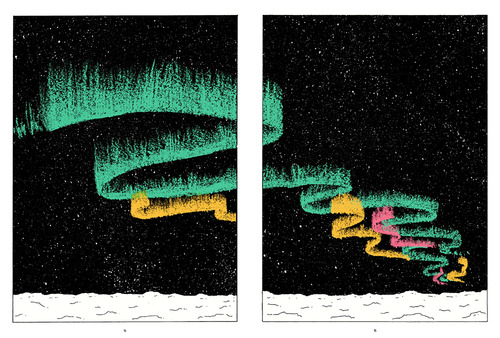
How to Survive in the North Interior Art by Luke Healy
Paste: What was being in school there like, as compared to your earlier educational experiences, in Ireland?
Healy: I mostly really enjoyed it. It was definitely more self-directed than my undergrad, which I liked. I do think by that point in my life, I was getting pretty sick of classroom environments, so I was happy to mostly spend my time working independently and just making a ton of comics.
More than anything, CCS introduced me to a world of comics that I didn’t know existed. More ambitious literary comics, “art comics,” self-published mini-comics—you name it and they had it in their library.
I also got to spend a lot of time around a community of peers who were as interested in making good comics as I was. I have a lot of great friends from CCS.
Paste: This book is your thesis project, right? What other topics did you consider for that capstone project? How did you know you’d found the right one?
Healy: I actually never considered any other options. I knew that I wanted to do a long book, and I knew that I wanted to do it about Ada Blackjack.
I’d come across her story years earlier and filed it away in my brain as a potential subject for a comic. When the time came at CCS to start working on our thesis projects, I did a little more research into her life, and discovered that by huge coincidence, her diary and many more primary sources of information about her expedition were publicly available in a library ten minutes away from the school.
I couldn’t refuse an opportunity like that.
Paste: So you found Ada Blackjack through a coincidence, right? And then went down the Wikipedia rabbit hole? Do you like research?
Healy: I enjoyed doing the research for this book. Outside of that, I don’t spend much time engaged in that sort of activity.
I’m more interested in current events than in history. I like learning and understanding things, in a broader sense. I find the process of working to learn something new to be very satisfying.
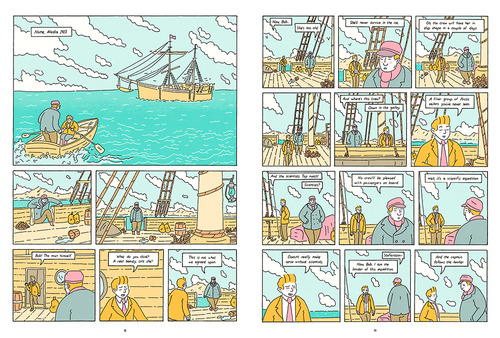
How to Survive in the North Interior Art by Luke Healy
Paste: Your process with this book made me think a little about Kate Beaton and her strips that draw on history, especially lesser-known historical figures whom she thinks should be better known. Thoughts?
Healy: I think that our work is pretty different, but I do enjoy reading her stuff. She is an excellent cartoonist.
Paste: What’s your drawing process like (materials, analog v digital balance, coloring, music on in the background, etc.)?
Healy: It varies from project to project, but usually it looks something like this:
I start by drawing all of the pages for the book as rough thumbnails. This step is the most important for me, as it’s where I work out all of the structure, compositions and dialogue. I typically do three or four drafts of these rough thumbnails.
Then, I’ll scan the roughs, add text, panel borders and gutters and anything else that needs to be very clear and legible. Then I’ll drop out the images, so I just have the text and panel borders, and print this out. Next, I fill in these pages with drawings, and then use a lightbox to trace out clean finished art. I draw almost everything with a cheap mechanical pencil on printer paper, including final art.
Usually, I scan and color digitally. I don’t love the look of digital color in general, but I try to think ahead to the print process, and tailor my coloring for the printed page. Usually, my work looks pretty bad on screens because it’s not designed to be displayed on screens. For me, the book is the final product.
I try to work in silence until the final steps of tracing and coloring the art. Then I’ll listen to podcasts or music.
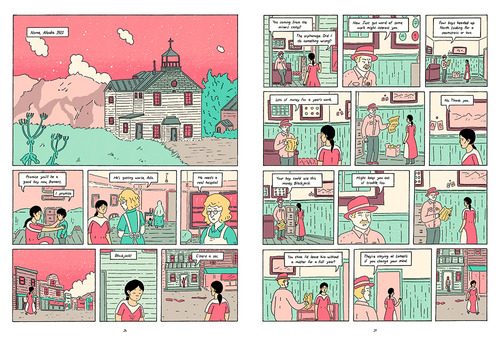
How to Survive in the North Interior Art by Luke Healy
Paste: You seem to split your time between web and print comics. Is there one you prefer? Why?
Healy: I prefer making comics for print because I prefer to read comics in print. I find that the experience is usually more impactful, and intimate—for me, at least. Most of the comics I have on my website were originally distributed in print, so they are designed to look best on the printed page. However, if I ever make a comic for the web, I specifically try to design the piece with that in mind from the start.
Paste: The color palette is one of the most striking things about this book, and you seem to work evenly in both color and black and white. How do you go about developing a color palette? Which do you prefer (color or b/w)?
Healy: Well thanks for saying so! For me, a good color palette is about working well within limits. For How to Survive, I knew that I wanted the book to be printed with four spot-colors, [or] inks different from the typical Cyan, Magenta, Yellow and Black used in most full-color printers. I chose these four colors, and then mixed and matched them in restrictive iterations (25%, 50%, 75%, etc.).
I deliberately chose garish, sort of warm colors for How to Survive. Partially I just wanted to defy expectations, and set myself a bit of a challenge. But I also deliberately wanted to reference old adventure comics, with their bright, poppy colors.
I try to choose whether or not to work in color from project to project. It’s usually a matter of economics. Anything I’m planning to self-publish in print will need to be in black and white, anything that’s going online will need to be in color, as people basically don’t share black and white images online. For How to Survive, I chose to work in color because I’d always planned on submitting it to a publisher.
Paste: There definitely seems to be a sort of tradition of comics using spot colors instead of CMYK, whether that’s through a risograph or a regular press. How did you learn about printing processes?
Healy: I studied magazine design and production as a part of my undergraduate degree in journalism, and in fact completed my thesis on that topic. So I had experience with, and knowledge of, the print production process from that. At CCS, we also had classes about comics production and reproduction technology.
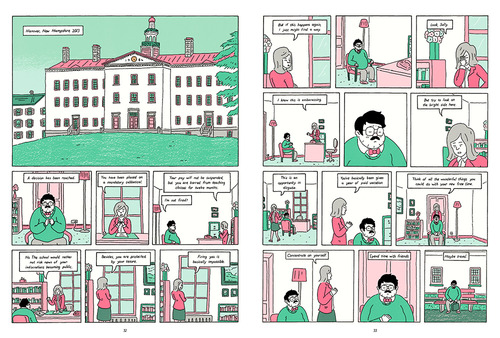
How to Survive in the North Interior Art by Luke Healy
Paste: Your publisher, Nobrow, seems especially interested in the possibilities of print. Would you say that’s true? How much control did you have over the printing process?
Healy: I think that’s true. Nobrow makes lots of thoughtfully produced books. When I pitched the book, I made it clear that I was designing the book for a four-spot-color process, so that was in place from the word go. I come from the DIY self-publishing world, so I have strong thoughts about every step of the design process, and I tried to communicate my preferences clearly.
However, I was also confident that Nobrow would produce a beautiful book no matter what, so I wasn’t a control freak about anything. At least, I hope not. I pretty much made whatever changes they suggested.
Paste: Equally interesting, but perhaps less immediately striking, are your character design. Your drawings are fairly simplified, so it’s important that the characters are distinguishable from one another. How much did you base them on reality? Is there anything you tweaked?
Healy: All of the characters are based on the photos I could find of the real people. I didn’t tweak much.
I like for my characters to look the same no matter what size I draw them. So I need to design the characters to be very minimal, which keeps them identifiable when drawn at a very small size, but then adds a weird, reductive filter when we see them drawn larger, which I like.

How to Survive in the North Interior Art by Luke Healy
Paste: Speaking of sizes and characters, do you tend to draw your pages at the same size they’ll be printed? Bigger? Smaller?
Healy: I usually draw things at the size they will be printed, or slightly larger. I used to work a lot larger, as reducing the size of artwork lends to the crisp, clean aesthetic that I think was at the center of my work for a long time.
These days, I’m more obsessed with efficiency as a key element of my comics aesthetic, and drawing at print size is simply more economical, time-wise. I’m always looking to dismantle any kind of preciousness in my work, and being ok with the kind of weird drawings that make their way into my work when I draw at print size is a big part of that.
Paste: How would you describe your relationship with nature? Did you grow up in an urban or a rural environment? Do you go camping?
Healy: I grew up in a weird empty suburb of Dublin City. I’d say I had an OK balance of indoors and outdoors growing up, but I would always have chosen indoors as a kid. It’s funny you should ask about camping. I just spent the last five months hiking from Mexico to Canada on the Pacific Crest Trail. It was cool. I’d never gone camping before my first night in the California desert, but I got used to it pretty quick.
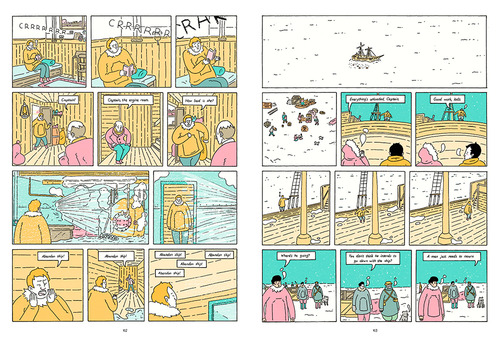
How to Survive in the North Interior Art by Luke Healy
Paste: Ireland’s nature seems relatively tame (groomed by sheep and such), especially in comparison to Wrangel Island and its polar bears. Do you think you have a lust for adventure?
Healy: I certainly crave new experiences. And I try at all times to be open, confident and assertive in my efforts to find and have those new experiences.
Paste: Were you camping by yourself? How do you deal with isolation?
Healy: I camped mostly by myself for the first half of the trail, however after a night of some mountain lions roaring at my tent for hours on end, I tried to camp with other hikers as often as possible. On the trail, there were a few days I was certainly glad to see familiar faces, and I feel as though I made good, lifelong friends out there.
I think I deal with isolation pretty well. I’ve grown more and more social as I’ve gotten older, but I’m still happy with my own company. I feel lucky that I’m satisfied by creative work. It means I’m rarely bored.
Paste: If I had to boil this book’s themes down to an oversimplified statement, I might say it’s about loneliness v. the difficulty of trusting other people. Accurate?
Healy: I think those themes are present in the book. I see the central theme of the book to be about the power dynamics of interpersonal relationships. It definitely explores the question of whether it’s better to strive for true self-sufficiency or to allow yourself to be vulnerable with another person.